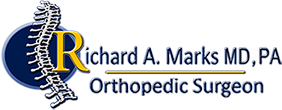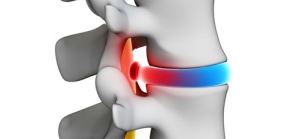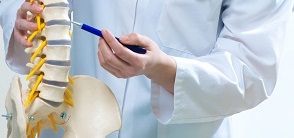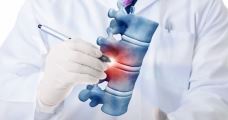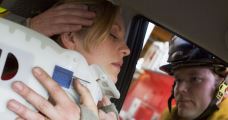Basic Anatomy of the Spine
The spine is an amazing creation, and plays an important role in both stabilizing the body and protecting the vast network of nerves which flow from the brain. It is made up of a series of bones, one on top of another, from the skull all the way down to the tailbone. From the front, it looks like a Halloween skeleton. The spaces between each bone, or vertebra, are filled with soft spongy discs. Those discs are shock absorbers for the spine, and keep the spine flexible.
What is a Normal Disc?
 Think of a disc as an oddly shaped (and very thick) jelly filled, rubber doughnut squashed between each back bone. This pliable doughnut acts as a brilliantly designed hydraulic shock absorber between each back bone. The “jelly” is the substance which gives “bounce” to the disc. in real life, it is called the nucleus. The “rubber doughnut” is the surrounding barrier which holds the jelly in place. In real life it is called the annulus.
Think of a disc as an oddly shaped (and very thick) jelly filled, rubber doughnut squashed between each back bone. This pliable doughnut acts as a brilliantly designed hydraulic shock absorber between each back bone. The “jelly” is the substance which gives “bounce” to the disc. in real life, it is called the nucleus. The “rubber doughnut” is the surrounding barrier which holds the jelly in place. In real life it is called the annulus.
Pictured to the left is a normal disc. The intact oval “rubber doughnut”, or annulus, is pictured in grey, and the contained “jelly”, or nucleus, is shown in red. The downward arrow indicates the normal force the shock absorbing disc is meant to withstand on a daily basis. The thick green column behind the disc represents the spinal cord, with the smaller offshoots being the branches, or nerve roots.
What is a Cracked, or Fissured Disc?
 Pictured to the right is a cracked or fissured disc. It is also known as an internal disc derangement.
Pictured to the right is a cracked or fissured disc. It is also known as an internal disc derangement.
Fissuring of a disc occurs when some force or combination of circumstances (represented here by the thicker downward arrow) causes cracks in the annulus.
The result is frequently back pain or neck pain, depending on its location in the spine. This situation may or may not cause symptoms in arms or legs.
Dr. Marks and his medical staff have the expertise to properly diagnose cracked or fissured discs.
What is a Bulging Disc or Protruding Disc?
 Pictured to the left is a bulging or protruding disc. When the cracks are larger or the “annulus” (“rubber doughnut”) is weaker, the force of the nucleus, or “jelly” naturally pushing out in all directions finds the path of least resistance where the nucleus is most damaged. Just like an area of very thin rubber in an inflated car tire, the weakened spot will bulge, or protrude.
Pictured to the left is a bulging or protruding disc. When the cracks are larger or the “annulus” (“rubber doughnut”) is weaker, the force of the nucleus, or “jelly” naturally pushing out in all directions finds the path of least resistance where the nucleus is most damaged. Just like an area of very thin rubber in an inflated car tire, the weakened spot will bulge, or protrude.
Note the nerve root adjacent to the bulging disc is colored in red. This angry color is meant to demonstrate irritation of the nerve, as it is being forced out of its normal uninterrupted route from the spinal canal to the tissues to which it supplies power.
What is a Herniated Disc?
 Pictured to the right is a herniated disc. When the crack is all the way through the annulus, the nuclear material will often squirt out, like toothpaste being squeezed out of its tube when the cap is off.
Pictured to the right is a herniated disc. When the crack is all the way through the annulus, the nuclear material will often squirt out, like toothpaste being squeezed out of its tube when the cap is off.
The problem is what is on the receiving end of that displaced nuclear material. It is not a toothbrush, rather it is sensitive nerve roots, or possibly the spinal cord itself.
Dr. Marks and his spine team have the experience and background to properly diagnose and treat herniated discs. We will consider conservative treatments first. If surgery is needed, we will thoroughly discuss all appropriate options.
Causes of Problematic Discs
While a disc problem can occur in in any area of your spine, the most common is the lower back. Some of the typical causes are:
- Spine Injury
- Wear and Tear
Symptoms of Disc Problems
Because the location of an abnormal disc can be in the neck or back, and the types of tissue involved can vary, symptoms may be different for each individual. However, common symptoms include:
- Constant or Frequent Recurring Ache in the Back or Neck
- Pain, Numbness, Tingling and/or Muscle Weakness in Arms or Legs
Treatment for Disc Problems
There are multiple non surgical treatment options available today. They vary from rest to exercise, physical therapy to chiropractic care, and oral medications to specialized injections. Following a proper exam, Dr. Marks can help guide you towards any of these options. However, if non surgical, or conservative options fail and surgery is recommended, Dr. Marks uses the latest surgical advancements to properly treat the condition.
Breakthrough in Spine Surgery
 As pictured to the left, the Transcutaneous Lumbar Disc Resection (TDR) is meant to decrease the internal pressure of the nucleus on both the cracks in the disc and the surrounding nerves. Pictorially, this is represented by the upward direction of the black arrow. This minimally invasive procedure is often successful in allowing many patient candidates to avoid much larger surgery, such as fusions.
As pictured to the left, the Transcutaneous Lumbar Disc Resection (TDR) is meant to decrease the internal pressure of the nucleus on both the cracks in the disc and the surrounding nerves. Pictorially, this is represented by the upward direction of the black arrow. This minimally invasive procedure is often successful in allowing many patient candidates to avoid much larger surgery, such as fusions.
The concept of Transcutaneous Disc Resection (TDR) is that many disc problems are at least partially correctable, whereas the concept of a fusion is that a disc is beyond repair and must be replaced for any symptom relief. Our spine surgeon will need to evaluate your condition to recommend the best course of action.
Schedule an Appointment
Dr. Marks is currently accepting new patients for conditions such as a herniated disc. To schedule an appointment, please contact us online or call our Richardson office at 972-231-7100.
